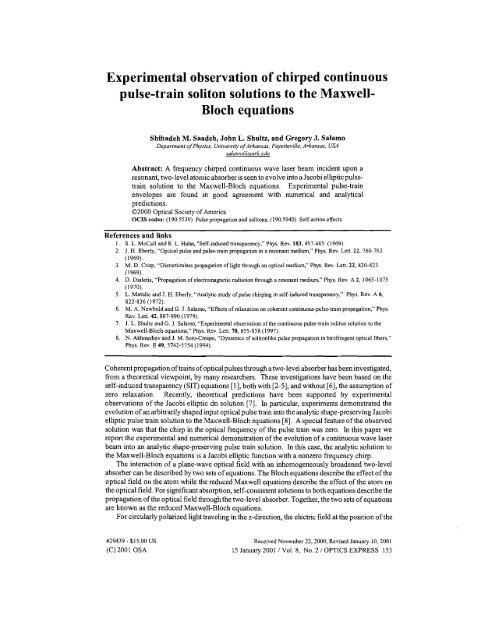Three - University of Arkansas Physics Department
Three - University of Arkansas Physics Department
Three - University of Arkansas Physics Department
You also want an ePaper? Increase the reach of your titles
YUMPU automatically turns print PDFs into web optimized ePapers that Google loves.
Experimental observation <strong>of</strong> chirped continuous<br />
pulse-tr ain soliton solutions to the Maxwell-<br />
Bloch equations<br />
Shihadeh M. Saadeh, John L. Shultz, and Gregory J. Salamo<br />
<strong>Department</strong> <strong>of</strong> <strong>Physics</strong>, <strong>University</strong> <strong>of</strong> <strong>Arkansas</strong>, Fayetteville, <strong>Arkansas</strong>, USA<br />
Abstract: A frequency chirped continuous wave laser beam incident upon a<br />
resonant, two-level atomic absorber is seen to evolve into a Jacobi ellipticpulsetrain<br />
solution to the Maxwell-Bloch equations. Experimental pulse-train<br />
envelopes are found in good agreement with numerical and analytical<br />
predictions.<br />
02000 Optical Society <strong>of</strong> America<br />
OCIS codes: (190.5530) Pulse propagation and solitons, (190.5940) Self-action effects<br />
References and links<br />
I. S. L. McCall and E. L. Hahn, "Self-induced transparency," Phys. Rev. 183,457-485 (1969).<br />
2. J. H. Eberly, "Optical pulse and pulse-train propagation in a resonant medium," Phys. Rev. Lett. 22, 760-762<br />
(1969).<br />
3. M. D. Crisp, "Distortionless propagation <strong>of</strong> light through an optical medium," Phys. Rev. Lett. 22, 820-823<br />
(1969).<br />
4. D. Dialetis, "Propagation <strong>of</strong> electromagnetic radiation through a resonant medium," Phys. Rev. A 2, 1065.1075<br />
(1970).<br />
5. L. Matulic and J. H. Eberly, "Analytic study <strong>of</strong> pulse chirping in self-induced transparency," Phys. Rev. A 6,<br />
822-836 (1972).<br />
6. M. A. Newbold and G. J. Salamo, "Effects <strong>of</strong> relaxation on coherent continuous-pulse-train propagation," Phys.<br />
Rev. Lett. 42, 887-890 (1979).<br />
7. J. L. Shultz and G. J. Salamo, "Experimental observation <strong>of</strong> the continuous pulse-train soliton solution to the<br />
Maxwell-Bloch equations," Phys. Rev. Lett. 78, 855-858 (1997).<br />
8. N. Akhmediev and J. M. Soto-Crespo, "Dynamics <strong>of</strong> solitonlike pulse propagation in birefringent optical fibers,"<br />
Phys. Rev. E 49,5742-5754 (1994).<br />
Coherent propagation <strong>of</strong> trains <strong>of</strong> optical pulses through atwo-level absorber has beeninvestigated,<br />
from a theoretical viewpoint, by many researchers. These investigations have been based on the<br />
self-induced transparency (SIT) equations [I], both with [2-51, and without [6], the assumption <strong>of</strong><br />
zero relaxation. Recently, theoretical predictions have been supported by experimental<br />
observations <strong>of</strong> the Jacobi elliptic dn solution [7]. In particular, experiments demonstrated the<br />
evolution <strong>of</strong> an arbitrarily shaped input optical pulse train into the analytic shape-preserving Jacobi<br />
elliptic pulse train solution to the Maxwell-Bloch equations [8]. A special feature <strong>of</strong> the observed<br />
solution was that the chirp in the optical frequency <strong>of</strong> the pulse train was zero. In this paper we<br />
report the experimental and numerical demonstration <strong>of</strong> the evolution <strong>of</strong> a continuous wave laser<br />
beam into an analytic shape-preserving pulse train solution. In this case, the analytic solution to<br />
the Maxwell-Bloch equations is a Jacobi elliptic function with a nonzero frequency chirp.<br />
The interaction <strong>of</strong> a plane-wave optical field with an inhomogeneously broadened two-level<br />
absorber can be described by two sets <strong>of</strong> equations. The Bloch equations describe the effect <strong>of</strong> the<br />
optical field on the atom while the reduced Maxwell equations describe the effect <strong>of</strong> the atom on<br />
the optical field. For significant absorption, self-consistent solutions to both equations describe the<br />
propagation <strong>of</strong> the optical field through the two-level absorber. Together, the two sets <strong>of</strong> equations<br />
are known as the reduced Maxwell-Bloch equations.<br />
For circularly polarized light traveling in the z-direction, the electric field at the position <strong>of</strong> the<br />
#29439 - $15.00 US<br />
(C) 200 1 OSA<br />
Received November 22,2000; Revised January 10,2001<br />
15 January 2001 1 Vol. 8, No. 2 1 OPTICS EXPRESS 153













